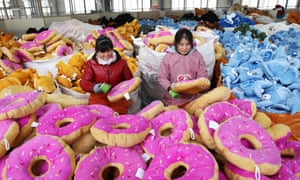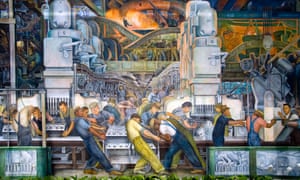By Ian Jack, The Guardian, March 14, 2018
The demise of the factory in the western world ranks high among the explanations for Brexit and Donald Trump. With it came the geographic isolation of the old factory lands from national prosperity, and the alienation of the former factory classes from the mainstream of British and American life. Furnaces lost their fires and smokestacks crashed to the ground. Industrial towns and cities grew ruinous – far too grand for the little business they now contained. People were poorer and felt that governments didn’t care.
The US lost roughly 5m manufacturing jobs between 2000 and 2016, while the UK lost 619,000 from 2006 to 2016 – adding in each country to the millions that had vanished in the previous three or four decades. An idea of the future also disappeared. These were regarded as “good jobs”: well paid (when they were skilled), secure, with regular hours, subsidised canteens and paid holidays. “The unionised giant factory helped create what many Americans look back at as a golden era of shared prosperity,” writes Joshua B Freeman of a recent time “when children did better than their parents and expected their children to do better than themselves.”
That factories could be sites of optimism sits uneasily with our ideas of the Dickensian 19th century and Blake’s satanic mills. To Engels, factory work was “nothing less than torture of the severest kind … in the service of a machine that never stops”. In Das Kapital, Marx wrote that while in handicrafts “the workman makes use of a tool, the factory makes use of him”. And yet ever since the Lombe brothers opened their silk mill in Derby in 1721, a brighter view of the factory has always persisted. The Derby mill was probably the first successful prototype, with a square, prison-like appearance that marked many thousands of its successors, buildings that in Freeman’s definition of a factory contained “a large workforce engaged in coordinated production using powered machinery”. Daniel Defoe saw this mill as a modern marvel, reacting to a visit there with a great explosion of facts (the machinery had 26,586 wheels and could produce 318,504,960 yards of silk thread every 24 hours), starting a tradition of awe-inspiring numbers that continues to this day in China, where it can take an hour to walk from one side of a factory to the other, and where in 2016, at peaks of production, 350,000 workers were employed to make iPhones in a factory complex in Zhengzhou.
Freeman has written a superb account of how the material world in his phrase became “factory made”. It takes us all the way from 18th-century Derbyshire to 21st-century China and spans the factory’s social, cultural, economic and political effects, as well as its technical progress. Almost every page contains a memorable fact or an intriguing thought, and by treating factories as a global phenomenon, Freeman has freed them from the cliches of the purely national narrative, which in Britain’s case familiarised generations of schoolchildren with very few innovations later than the spinning jenny and the power loom. Of course, British industrial production continued to develop long after those inventions, but the main thrust of factory history moved elsewhere – beyond Europe, to the US and the Soviet Union before its most recent incarnation in China, which, with the increased use of robotics, may be the last society shaped by the factory as a mass employer.
Women have a prominent place in this story, most notably after the factory crossed the Atlantic to New England, where cotton mills were set up on riverbanks that were often far from any large settlement. Separated from urban temptation and powered by water until after the civil war – coal deposits were inconveniently located – they enjoyed a more wholesome reputation than their smoky British ancestors. Like British textile factories, they depended on female labour to operate the machinery, while men took the better paid jobs in management and maintenance. In some New England mills, women made up 85% of the workforce. Unlike the typical Lancashire factory girl, they tended to be the literate daughters of farmers who returned to the homestead during downturns in trade rather than staying in their factory lodgings and making trouble; and thereby, as Freeman writes, “avoiding the discontent and disorder that came in England with the creation of a permanent proletariat”.
Paternalistic mill owners did their best to create a moral and improving atmosphere; the Lowell mills in Massachusetts even published a magazine of poetry and fiction for its workers. But what did more to change the lives of the mill women was money – that and an interval of self-discovery between daughterhood and wifehood that living away from home allowed. “The mills … provided an escape from families, rural life, boredom and isolation, a chance to experience a new, more cosmopolitan world of independent living, consumer goods and intense sociability,” Freeman writes, quoting a woman who remembered how a worker’s first wages could effect an enormous transformation: from “depressed, modest, mincing” girls into women who looked you in the face and “sang blithely among their looms”.
This was the factory effect at its gentlest. As the 19th century wore on, it showed its more brutal side, when the magnates such as Andrew Carnegie and Henry Clay Frick refused to improve the hellish conditions of their steel mills and broke up strikes ruthlessly and brutally. Freeman argues that mainstream ideology is mistaken when it associates the achievements of the industrial revolution with individual liberty and the free market. Factories often did best in the opposite conditions, growing up, like the British textile and American iron and steel industries, in a climate of “denied political rights – free speech, free assembly, rule of law”. If more examples are needed to support Freeman’s argument, look no further than China’s present role as factory to the world.
Taylorism, Fordism, fascism: Freeman shows how our love-hate relationship with the factory blossomed once again in the 1920s and 30s – the production line hell of Chaplin’s Modern Times on the one hand and Diego Rivera’s heroic Detroit murals on the other. The author’s sympathy, insight and exemplary anecdotes make this a marvellous book.



No comments:
Post a Comment